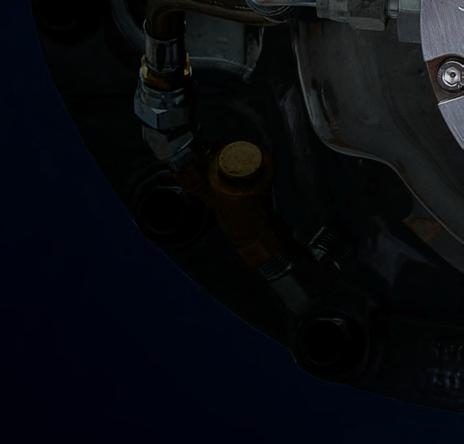
13 minute read
Every Last Drop
EVERY DROP
MOTORISTS AND PROFESSIONAL DRIVERS EXPECT, AS A MINIMUM, TO BE ABLE TO FILL THEIR FUEL TANKS WHENEVER A SERVICE STATION IS OPEN. THE LONG DISTANCES BETWEEN CENTRES OF CIVILISATION IN SOME PARTS OF AUSTRALIA OF COURSE PRESENT A CHALLENGE FOR THE DISTRIBUTION OF FUEL – A CHALLENGE WILLINGLY TAKEN UP BY HUNTS FUEL IN SOUTH AUSTRALIA.
David Hunt is a secondgeneration fuel distributor having started work for his parents Kevan and Ann in 1978 – originally with BP, then Ampol, and eventually Caltex following the two oil companies’ merger in 1995. In 1982 he became part owner and the Company KS & CA Hunt & Son Pty Ltd, trading as Hunts Fuel was formed. David is joined in the business by his wife Patricia, sons Jamie, Damien and Daniel and mother Ann. A proud Caltex Franchise Distributor, with its Head Office located in Jamestown, Hunts Fuel delivers bulk fuel to its network of retail service stations as well as to small and large businesses including primary producers, transport operators, civil works, mines, marine and rail, and local government entities. To keep the trucks busy for 12 months of the year, Hunts Fuel endeavour to have an even balance between retail and wholesale operations. More recently, in 2017, Hunts Fuel expanded to the Eyre Peninsula region following the acquisition of a number of Caltex equity operations which have since been absorbed into the business. With depots located in Jamestown, Kadina, Maitland, Port Augusta, Port Lincoln and Wudinna, Hunts Fuel now employs more than 30 staff. Fuel in Port Lincoln on the West Coast, where it was previously delivered to the local terminal by ship, now arrives by road from the Pelicon Point Terminal in Adelaide or Port Bonython Terminal in Whyalla by roadtrain. Hunts Fuel’s

marketing area across the state includes the Mid North, North East, Yorke and Eyre Peninsula Regions and extends from Adelaide to Coober Pedy in the north and now Penong, Ceduna and Fowlers Bay to the west. Fuel trucks have progressed significantly since the second hand Bedford that Kevan Hunt received as a component of the package when he purchased his first fuel distributorship. At present, the tanker fleet consists of 12 Scania prime movers and one rigid tanker. The relationship between Hunts Fuel and the Scania brand extends back to the mid-1980s when a second-hand Super 80 which had previously worked as a car carrier was converted to become a rigid tanker. This was later followed by a new twin steer, bogie drive Scania 112H which David recalls having 1.2 million kilometres on its odometer when it was finally replaced. “That was a magnificent truck which was actually someone else’s cancelled order,” David says. “I was able to do a deal with Diesel Motors in Adelaide and the rest is history. It was one of the first intercooled models with 330 horsepower and we had an incredible run with it with no engine or even turbo problems while we had it.” The company delivers fuel with roadtrain combinations and single tri-axle tankers. “The trailers cost a lot to set up but can have a working life of 15 to 20 years if the maintenance is kept up and as long as the barrels don’t fatigue or crack” says David. “A new rigid tanker may take two months to be fitted up with the necessary pumps and other equipment at substantial cost,
COUNTS
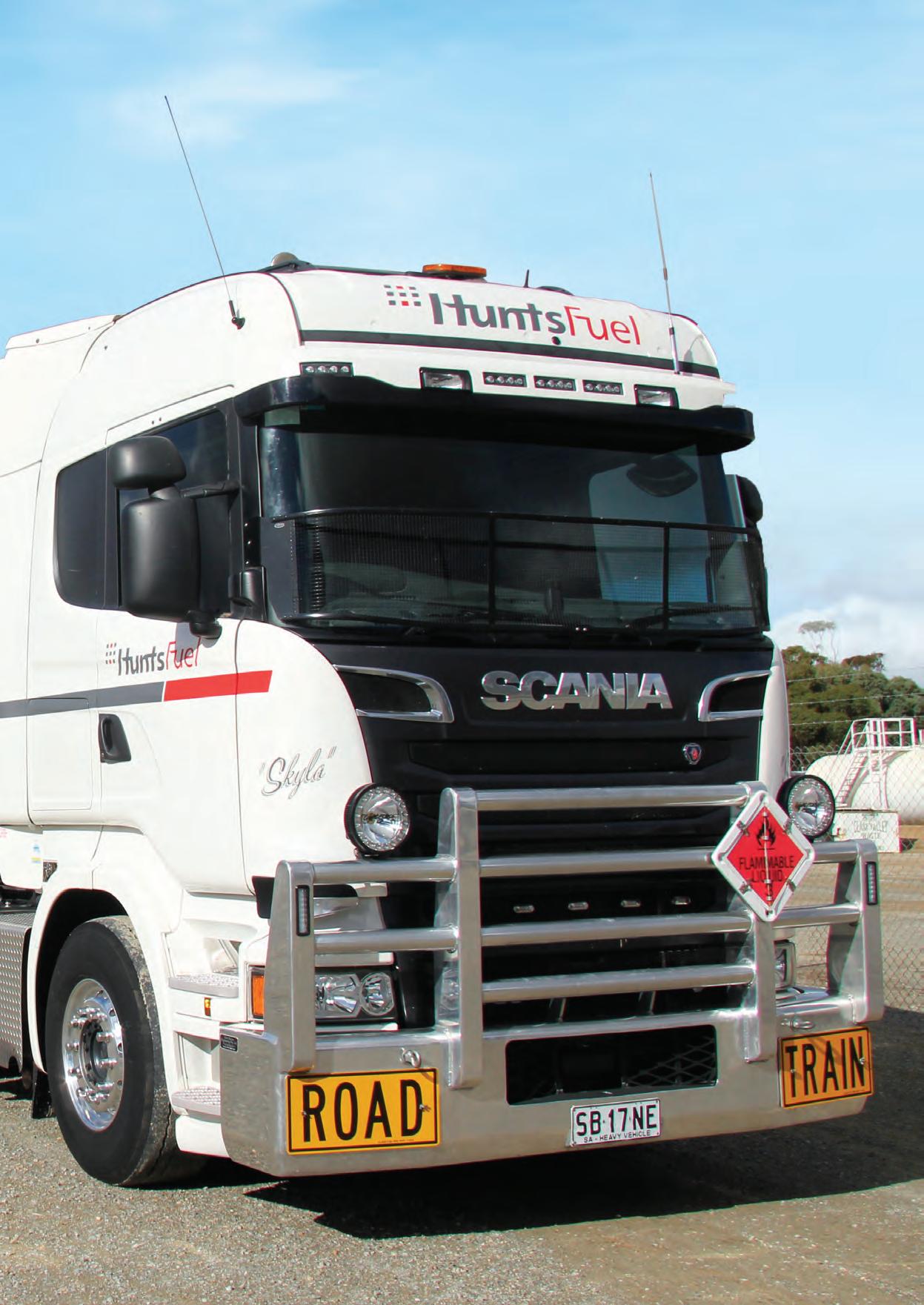
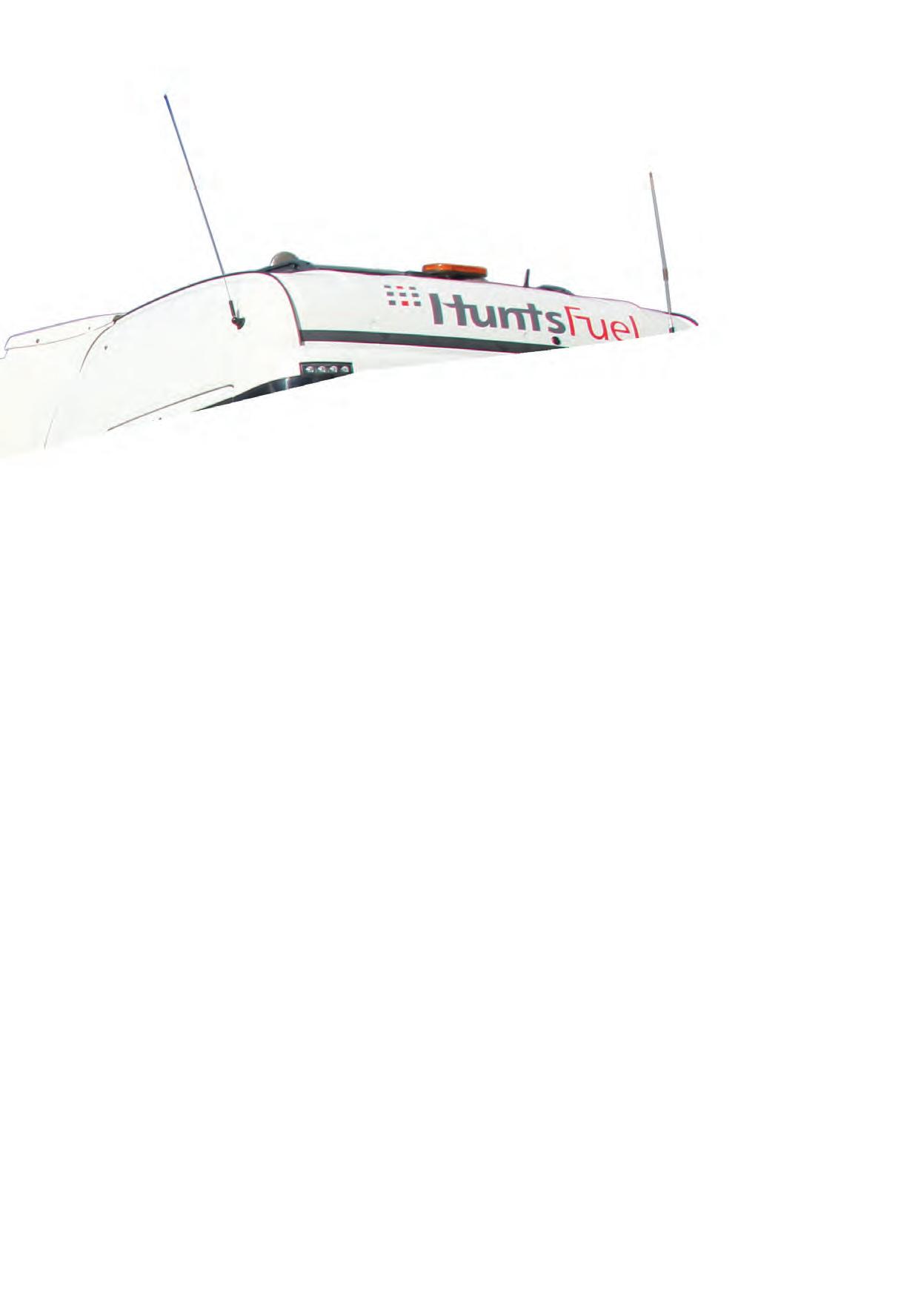
compared to purchasing an additional prime mover and immediately connecting this to an existing trailer or combination.” To this day Hunts Fuel continues to purchase Scania trucks and presently has Euro 5 and Euro 6 models. “Scania vehicles are comfortable, quiet, reliable, fuel efficient and cost effective,” says David. “They’re a good product, good to drive and environmentally friendly.” Impressed by Scania’s driver assistance and scoring systems, David recognises they help the drivers contribute to the overall efficiency and safety of the trucks. Most of the Scania’s are now on Scania Repair and Maintenance contracts which David regards as an advantage as there are no arguments over repair bills. Other than greasing the tail shafts and keeping a general eye on the mechanical condition ofthe trucks all other repairs and maintenance is left up to the service centre. “Our trucks are fitted with the Scania Retarder,” says Jamie Hunt. “They are so effective that I can’t remember ever replacing the brake pads on a Scania.” Broad acre farming demands a lot of diesel particularly during peak seasons of seeding and harvesting. Over the years farming equipment has developed to become much larger pieces of machinery and landholders consequently require larger deliveries. Where once a rigid tanker performed the farm deliveries, semi-trailers and even roadtrains can access the same properties today. Most of Hunt’s trailers are configured with six separate compartments and each truck is fitted with pumps and metering kits to accurately measure petrol and diesel deliveries. As a function of the mass management scheme in which Hunts Fuel operates, the scheduler creates a load profile for each driver who receives it via a tablet in the cab. The profile takes into account the various densities of different fuels so the truck can be loaded with confidence. David explains that to ensure compliance Hunts Fuel obtain the fuel densities daily and calculate the load weights, but to be safe periodical weighbridge checks are also performed to ensure compliance with the axle load limits.
Given the remoteness of locations each Hunts Fuel truck is tracked by satellite.
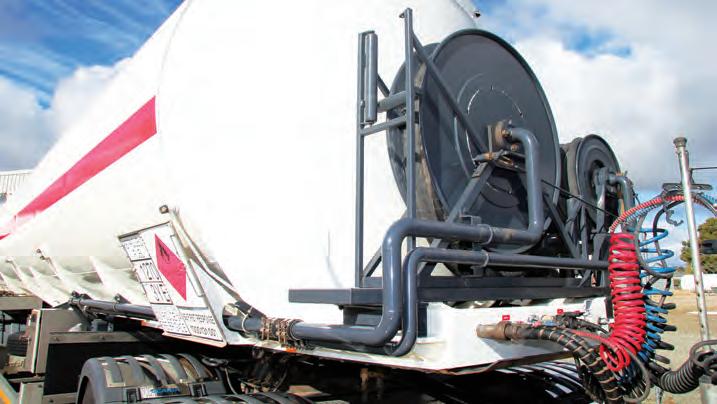
The expansion of Hunts Fuel, more recently, has created some opportunities to improve efficiency by taking advantage of the additional terminals and depots which they now have access to and sometimes are able to carry some fuel on return legs. However, the long distances between supply and delivery points can present a special set of logistics challenges and it’s vital to properly plan for some of the ‘local’ deliveries out of the more remote depots as a seemingly simple two hour job can jeopardise an entire shift and strand a driver under the fatigue regulations. Due to the remoteness of many of the areas in which they operate it is important that each truck is tracked by satellite. All of Hunts Fuel Mass, Maintenance and Fatigue management programme is coordinated via the National Heavy Vehicle Accreditation Scheme. “The NHVR is efficient and informative,” says David. “For our needs the required permits are accessed through the NHVR portal with ease.” In today’s business world, David spends more time at his desk than out in the field, although he still enjoys occasionally getting out in a fuel tanker himself. He misses the one on one customer contact that he experienced in his early years as a driver, and he is particularly appreciative of the hospitality of people living on remote stations for whom the fuel tanker driver may be the only ‘outsider’ they see in days. Another change David acknowledges is that the rural areas are suffering from the drift of young people to the cities or to the mines. “We’re fortunate to have mature and experienced drivers but I don’t see many young ones coming through and few are choosing the transport industry as a profession” he says. “Adapting to change can be hard in business. The natural instinct is to do things as you used to. We’ve learned to accept and embrace change because in this industry if you don’t change you don’t survive.” He adds, “Education is not just about learning; the process of learning is about the ability to learn”. David Hunt says he has thoroughly enjoyed his 40 years in business and is proud of where Hunts Fuel is today. He has a very strong commitment to the Caltex brand and hopes to continue to grow the future of Hunts Fuel and recognises his customers for their ongoing support. “The fuel business is in my blood and I can’t see myself doing anything else,” he says.
FAST FACT The Hunts Fuel headquarters remains in Jamestown although there are now larger depots in other centres due to the acquisition of the Caltex assets and facilities. David considered relocating the base to Adelaide but the expanded network is able to be well managed from Jamestown where the Hunt family is actively involved in its community.

THUN DER DAYS O F
FUSO IS ROLLING OUT ITS NEW GENERATION HEAVY-DUTY PRODUCT AS THE LARGEST MODEL IN THE FUSO FLEET TAKES A BIG LEAP FORWARD. THE JAPANESE BRAND RELEASED THE LATEST VERSION OF THE TRUCK, WHICH WAS INITIALLY CALLED HEAVY BACK IN MAY WHEN IT WAS UNVEILED AT THE BRISBANE TRUCK SHOW AS THE SHOGUN.
Named after Japan’s allpowerful military leaders, as appointed by the emperor, who ruled the country for centuries until 1869, the Shogun according to Justin Whitford, Fuso Truck and Bus Director, marks a revolutionary step for the brand. “It will set new standards for Japanese trucks and deliver our customers a clear advantage thanks to its leading Daimler technology that complements its legendary Fuso toughness,” he said. The integration of Daimler technology is not something that can be underestimated. Indeed, at the heart of the new Shogun range is a Daimler-developed engine family that has already been saving fuel for Mercedes-Benz customers since it was released locally in late 2016. Fuso has also confirmed it will offer the OM470 11-litre six-cylinder engine to its customers straight away and says an 8-litre unit is also in the pipeline. There is even a chance that the Australian Shogun will be made available with the 13-litre Daimler six, but at present Fuso was not yet able to confirm this. For now, there is strong interest in the OM470 11-litre in-line six-cylinder that will cover the demands of most operators. The OM470 uses the latest generation technology from Europe and delivers the kind of torque that only much larger engines could deliver in years gone by. It is a common rail engine featuring a special pressure booster and an asymmetric turbocharger, a feature that helps deliver more pulling power lower in the rev range. A key characteristic of the power unit is a potent decompression engine brake with up to 340kW of force. It is one of the features that has been given the big thumbs-up by Mercedes-Benz customers. The 11-litre engine will be available with two ratings; 400hp and 2000Nm and 460hp (335kW) and 2200Nm. More outputs may be on the way, but Fuso is confident these two will hit the sweet spot for many Australian operators, especially after an in-country evaluation program. The engine is coupled to a state-of-the-art 12-speed automated manual transmission that reduces driver fatigue and makes lowspeed manoeuvring easy. This new generation transmission has been developed with Australian customer needs in mind. Fuso says it works extremely well with the new and improved engine as it has more torque available more of the time in order to reduce the amount ofshifts required. The OM470 has reportedly delivered fuel economy improvements and a reduction in AdBlue consumption in New Zealand, where it was introduced early this year. The proven engine treats its exhaust using three different systems, Selective Catalytic
THUN DER

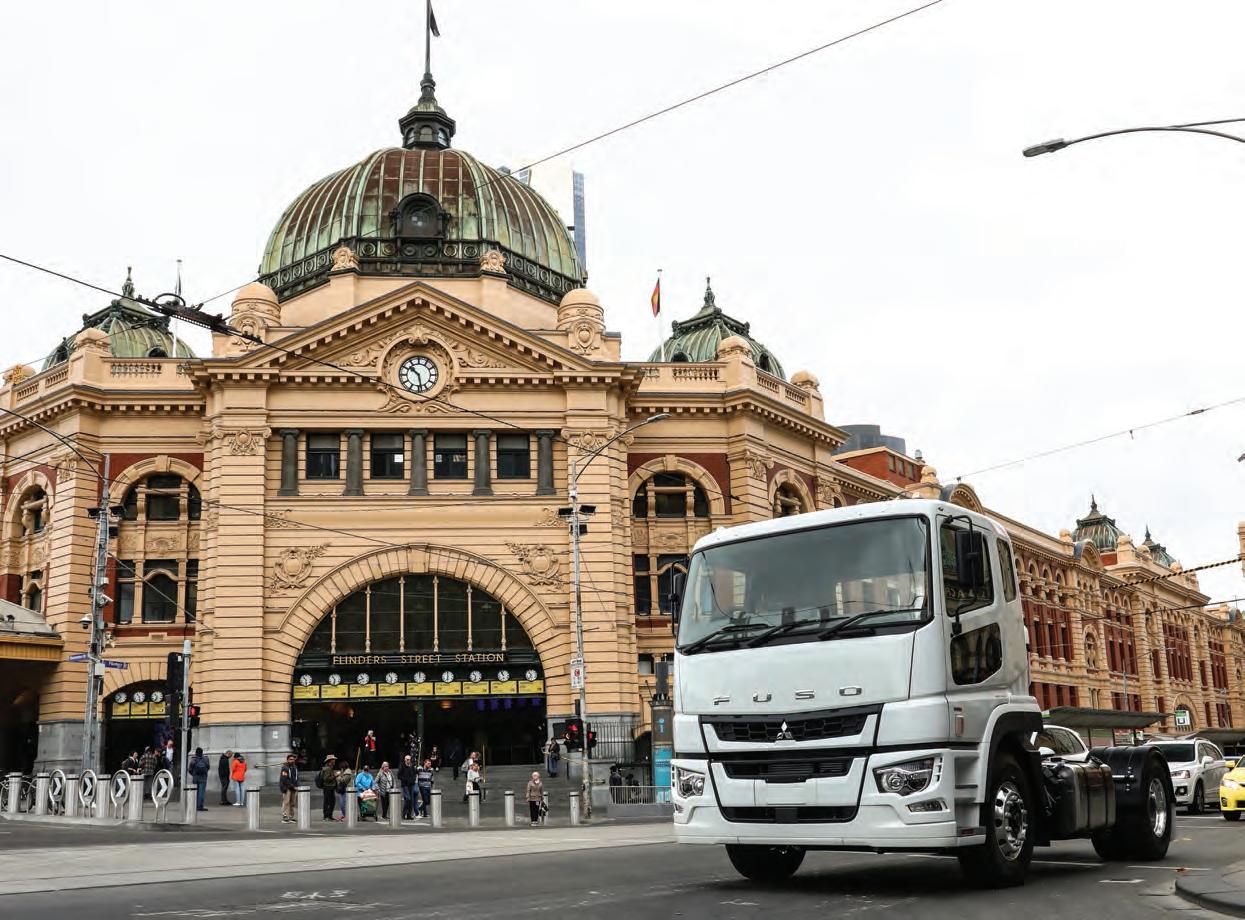
Proximity Control Assist will function as an aid to help operate the vehicle in heavy traffic.
Reduction (using AdBlue treatment fluid), Exhaust Gas Recirculation and a Diesel Particulate Filter. Importantly, this means the Shogun meets stringent Euro 6 emission standards, which will certainly appeal to those operators who are keen to limit carbon emissions in line with progressive customers who demand their freight is carried by cleaner trucks. Fuso says the introduction of the new powerplant means Shogun customers will also benefit from long service intervals of 50,000km, keeping running costs to a minimum. Safety was also high on the list of priorities for Fuso engineers, who also benefited from the Daimler group’s strength in this area. The Shogun features the latest electronic safety systems and comfort features, including adaptive cruise control (Proximity Control Assist) with stop and go function for heavy traffic, which should help make their job much easier. Unless traffic comes to a standstill for some time, the driver doesn’t need to touch the accelerator or brake and can simply concentrate on looking after the steering. Fuso also decided to include Advanced Emergency Braking as standard. This feature, which has also been rolled out across most models of the Canter range, can even initiate braking for moving pedestrians. Other safety technology includes Lane Departure Warning and Electronic Stability Control. The Shogun also includes a smart safety feature that enhances visibility to the left of the driver. It’s called a transom window and is basically an extra window below the armrest on the passenger side of the cab that increases visibility. An all-new interior delivers a high level of refinement, with Fuso engineers focusing on noise vibration and harshness suppression. There is also a fresh ergonomic layout with a driver-focused dashboard design ensuring controls are within easy reach. Many of the systems can be operated by steering wheel mounted buttons that enable drivers to keep their hands on the wheel. The longer hands stay on the wheel means more time eyes stay focused on the road. Sitting in between the speedo and tacho is a digital screen that displays a range of data including the gear selected, but also the speed, fuel consumption and other truck related information. Sitting to the left of the steering wheel is a new 7-inch touch screen complete with Bluetooth audio streaming and phone connectivity as well as truck-specific satellite navigation. The traditional key and ignition barrel has been replaced with a Start button, which is just like those found in Mercedes-Benz passenger cars and trucks. Fuso has launched the Shogun with prime mover and rigid options covering everything through to B-double work, including 6x4, 8x4 with load share front suspension and 4x2 configurations, and will offer steel and air suspension varieties. Gross Combination Weights run from 40,000kg to 63,000kg. It is covered by a manufacturer’s warranty of five years or 500,000km (whichever comes first).
DRIVE HEAD NEW AUSTRALIAN






FORCE-FED LUBRICATION



TOUGH OPERATION CONDITIONS
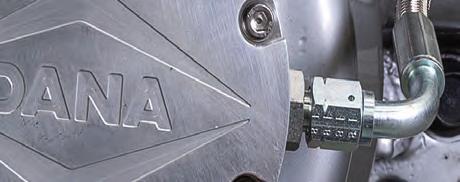
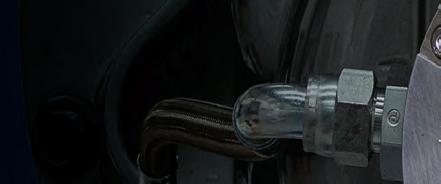


INCREASE LIFE-TO-OVERHAUL
MADE IN AUSTRALIA


